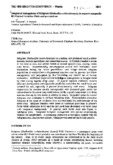| dc.contributor.author | Valverde, B.E. | |
| dc.contributor.author | Merayo, A. | |
| dc.contributor.author | Reeder. R. | |
| dc.contributor.author | Riches, C.R. | |
| dc.date.accessioned | 2014-10-17T16:04:41Z | |
| dc.date.available | 2014-10-17T16:04:41Z | |
| dc.date.issued | 1999 | es_ES |
| dc.identifier | 359452 | es_ES |
| dc.identifier.uri | https://repositorio.catie.ac.cr/handle/11554/2566 | |
| dc.description | 1 fig. 3 tab. 22 ref. Sum. (En) | es_ES |
| dc.description.abstract | Itchgrass (Rottboellia cochinchinensis) is a serious and persistent weed problem in many tropical agricultural and conservation areas. In Central America it is one of the most noxious and serious weeds in several upland crops, causing severe yield losses. Experimentally, pre-emergence control with herbicides, weed elimination during the fallow period and zero tillage reduced itchgrass populations in comparison to conventional practices used growers (no fallow management, soil preparation by disc harrowing and limited use of in-crop herbicides. Additional improvement in itchgrass management is brought about by inter-sowing legume cover crops. Of several legumes evaluated, mucuna (Mucuna deeringiana) and Canavalia ensiformis controlled the weed better and covered the soil, especially if planted simultaneously with maize. Itchgrass suppression by mucuna usually corresponded with increased grain yields but competition by the cover crop could reduce yields a good compromise is to delay mucuna planting by two weeks in relation to maize. Integrated tactics to control itchgrass were evaluated in on-farm validation plots. Pendimethalin controlled itchgrass at the onset of validation plots and facilitated the establishment of the cover crop. Itchgrass densities were lower in validation plots than in grower's fields while infestation levels and the soil seed bank decreased over three years with integrated management. In general, corn yields were also higher in validation plots. Integrated itchgrass management also proved economically feasible for smallholders. A promising alternative is biological control with the itchgrass smut, Sporisorium ophiuru, which prevents seed set and its host specific | es_ES |
| dc.language.iso | en | es_ES |
| dc.publisher | Brighton Crop Protection Council, Surrey (RU) | es_ES |
| dc.subject | ZEA MAYS | es_ES |
| dc.subject | ROTTBOELLIA COCHINCHINENSIS | es_ES |
| dc.subject | MUCUNA DEERINGIANA | es_ES |
| dc.subject | CANAVALIA ENSIFORMIS | es_ES |
| dc.subject | COMPETENCIA | es_ES |
| dc.subject | BIOLOGICA | es_ES |
| dc.subject | SOSTENIBILIDAD | es_ES |
| dc.subject | PLANTAS DE COBERTURA | es_ES |
| dc.subject | CONTROL BIOLOGICO | es_ES |
| dc.subject | AMERICA CENTRAL | es_ES |
| dc.title | Integrated management of itchgrass (Rottboellia cochinchinensis) in maize in seasonally-dry Central America: facts and perspectives | es_ES |
| dc.title.alternative | Proceedings | es_ES |
| dc.type | MON | es_ES |
| dc.identifier.publication | (RU) | es_ES |


